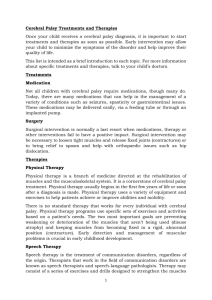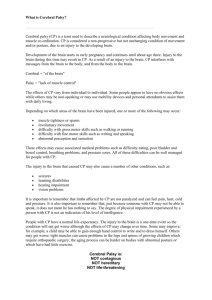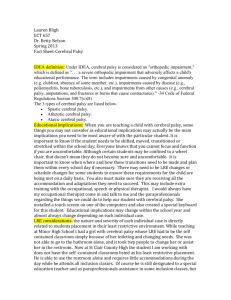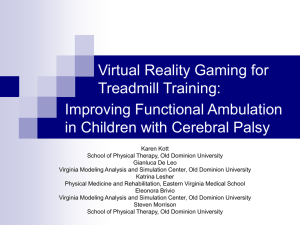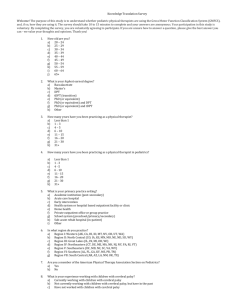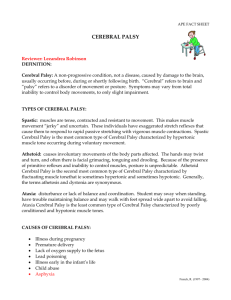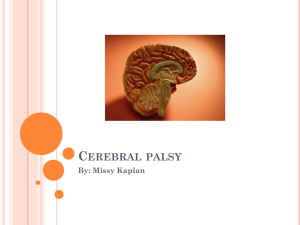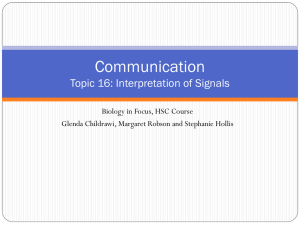Benedict - University of Wisconsin
advertisement
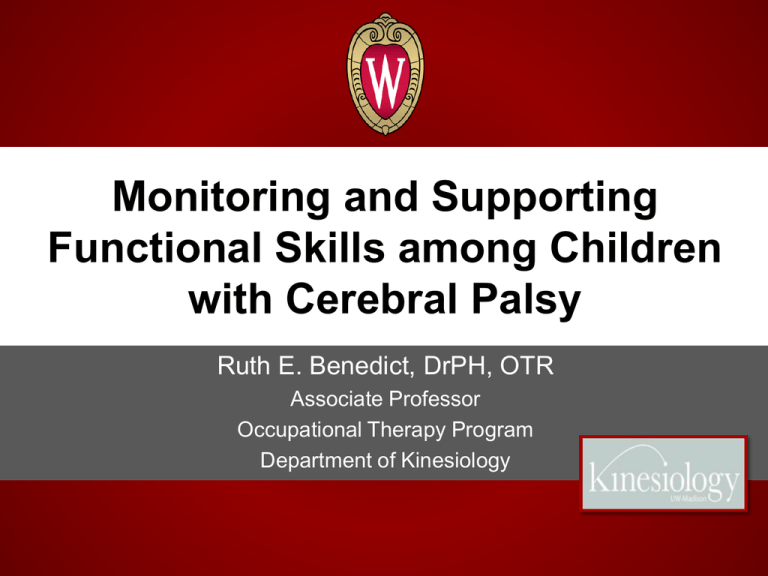
Monitoring and Supporting Functional Skills among Children with Cerebral Palsy Ruth E. Benedict, DrPH, OTR Associate Professor Occupational Therapy Program Department of Kinesiology Objectives • To provide an overview of the strengths and limitations of classification systems and assessment tools for determining function among persons with CP • To present current estimates of the prevalence of gross motor function abilities among children with CP • To examine evidence for interventions intended to maximize function and support caregiving OCCUPATIONAL THERAPY PROGRAM, UNIVERSITY OF WISCONSIN-MADISON Function & Participation Why care about function? • As therapists, that is what we do • Social vs. Medical model – International Classification of Functioning, Disability & Health (ICF) – Role of Environment • Predict future supports & service needs • Program planning & policy OCCUPATIONAL THERAPY PROGRAM, UNIVERSITY OF WISCONSIN-MADISON Functional Limitations • Are associated with: – Greater need for services • Home health, Equipment, Therapy, Special Ed – Greater impact on family – Decreased access to health care services – Inadequate insurance – Perceived poorer quality interactions with providers OCCUPATIONAL THERAPY PROGRAM, UNIVERSITY OF WISCONSIN-MADISON Functional Classification Gross Motor Function Classification System (GMFCS) – Palisano, R., Rosenbaum, P., Walter, S., Russell, D., Wood, E., Galuppi, B. (1997). Development and reliability of a system to classify gross motor function in children with cerebral palsy. Developmental Medicine and Child Neurology, 39, 214-223. Manual Abilities Classification System (MACS) – Eliasson, A.-C., Krumlinde-Sundholm, L., Rösblad, B., Beckung, E., Arner, M., Ohrvall, A.-M., et al. (2006). The Manual Ability Classification System (MACS) for children with cerebral palsy: scale development and evidence of validity and reliability. Developmental Medicine and Child Neurology, 48(7 (Print)), 549-554. OCCUPATIONAL THERAPY PROGRAM, UNIVERSITY OF WISCONSIN-MADISON 5 Levels of GMFCS LEVEL I - Walks without Limitations LEVEL II - Walks with Limitations LEVEL III - Walks Using a Hand-Held Mobility Device LEVEL IV - Self-Mobility with Limitations; May Use Powered Mobility LEVEL V - Transported in Manual Wheelchair OCCUPATIONAL THERAPY PROGRAM, UNIVERSITY OF WISCONSIN-MADISON What does the GMFCS tell us? • Prediction of future motor ability – Reliable after 2 years of age • Answer or clarify common questions: – “Will my child ever walk?” • Guide treatment approaches and goals • Client/Caregiver education regarding long term equipment and care needs OCCUPATIONAL THERAPY PROGRAM, UNIVERSITY OF WISCONSIN-MADISON Stability & Decline of Function Hanna, S.E., Rosenbaum, P.L., Bartlett, D.J., Palisano, R.J., Walter, S.D., Avery, L., Russell, D.J. (2009). Stability and decline in gross motor function among children and youth with cerebral palsy aged 2 to 21 years. Developmental Medicine & Child Neurology, 51(4):295-302. MACS Level I: Handles objects easily and successfully. Do not restrict independence in daily activities. Level II: Handles most objects but with somewhat reduced quality and/or speed of achievement; alternative ways of performance might be used. Level III: Handles objects with difficulty; needs help to prepare and/ or modify activities. Activities are performed independently of they have been set up or adapted. Level IV: Handles a limited selection of easily managed objects in adapted situations. Requires continuous support and assistance and/or adapted equipment. Level V: Does not handle objects. Requires total assistance. OCCUPATIONAL THERAPY PROGRAM, UNIVERSITY OF WISCONSIN-MADISON Research to Practice Surveillance Common Interventions Spasticity management ▲ Baclofen, Dantroline, Tizanidine Botox, Selective dorsal rhizotomy, Diazepam Contracture management NDT (Neurodevelopmental Training) ▲ Casting UE, Orthotics, Hand surgery Casting LE Muscle strengthening ▲ Electrical stimulation, Strength training Bone Density Bisphosphonates ▲ Standing frames, Vitamin D, Vibration Novak, I., McIntyre, S., Morgan, C., Campbell, L., Dark, L., Morton, N., Stumbles, E., Wilson, S., Goldsmith, S. (2013). A systematic review of intervetnions for children with cerebral palsy: State of the evidence. Dev Med & Child Neuro, 55:885-910 Motor Function NDT, SI (Sensory Integration), Hyperbaric O2 ▲ Biofeedback, Hydrotherapy, Hippo-therapy ▲ SEMLS (Single Event Multilevel Surgery/Therapy) ▲ Therasuits, Conductive education, Vojta (reflex locomotion) Goal-directed training CIMT, Bimanual training OT (post UE Botox) Context-focused therapy, Home programs Novak, I., McIntyre, S., Morgan, C., Campbell, L., Dark, L., Morton, N., Stumbles, E., Wilson, S., Goldsmith, S. (2013). A systematic review of intervetnions for children with cerebral palsy: State of the evidence. Dev Med & Child Neuro, 55:885-910 Improved Function & Self-care ▲ NDT ▲ Pharmaceuticals (Botox, ITB) ▲ Selective dorsal rhizotomy ▲ Assistive devices, seating/positioning, Orthotics ▲ Massage, Sensory processing Goal-directed training Home programs Novak, I., McIntyre, S., Morgan, C., Campbell, L., Dark, L., Morton, N., Stumbles, E., Wilson, S., Goldsmith, S. (2013). A systematic review of intervetnions for children with cerebral palsy: State of the evidence. Dev Med & Child Neuro, 55:885-910 Communication ▲ Training, AAC, Social stories, Oro-motor Mealtime management ▲ Gastrostomy, Dysphagia management, Fundoplication, Oro-motor Behavior & social skills ▲ Behavior therapy, Social stories, Play therapy Parent coping ▲ Behavior therapy, Communication training, Coaching/Counseling Novak, I., McIntyre, S., Morgan, C., Campbell, L., Dark, L., Morton, N., Stumbles, E., Wilson, S., Goldsmith, S. (2013). A systematic review of intervetnions for children with cerebral palsy: State of the evidence. Dev Med & Child Neuro, 55:885-910 Marcella Andrews, MPT, PCS Dan M. Bolt, PhD Michael Braun, MS, OTR Ruth E. Benedict, DrPH, OTR Model of Caregiving Model of Caregiving Caregiver Characteristics Child Characteristics Caregiver Strain Measures Age BMI (based on weight & height) Baseline Heart rate Baseline Volume of oxygen Function GMFCS, MACS, CP Child Personal Weight, length, age, type of CP, BAD Score Caregiving Demands Subjective Borg Ratings of Perceived Exertion Scale Objective Heart rate (HR); Volume of oxygen consumption (VO2) Adapted from: Raina, P., O'Donnell, M., Rosenbaum, P., et al. (2005) Methods Participants: Primary caregivers (N=19) of children and young adults with cerebral palsy (ages 3-22 years) receiving an Intrathecal Baclofen Pump who were recruited through a Spasticity & Movement Disorders clinic. Procedures: Caregivers completed 3 successive tasks: 1) transfer wheelchair to mat 2) dressing 3) transfer from mat to wheelchair Mean (Standard Deviation) Caregivers N = 19 Relation Mother Father Age < 45 years >= 45 years Weight (Kilograms) Height (Centimeters) Percent (at baseline) 89% 11% 0 months (N=19) 6 months (N=14) 12 months (N=8) ------- ------- -------- 41.9 (7.0) 42.6 (7.8) 44.7 (7.6) 53% 47% ---------- 80.0 (22.4) 85.9 (28.0) 86.0 (25.0) ---------- 165.1 (9.1) 167.6 (8.9) 167.6 (7.6) BMI < 30 >= 30 HR (bpm) 58% 42% ---------- VO2 (mL/kg/min) ---------- 29.1 (6.8) 30.2 (8.6) 30.6 (9.0) 73.5 (11.2) 73.5 (9.7) 74.4 (8.9) 11.7 (2.5) 11.4 (2.4) 12.3 (1.4) Correlations between subjective and objective measures of energy exertion Borg RPE (N=114) HR (N=116) Borg RPE HR .182 VO2 .488* .363* Controlling for Baseline HR & VO2 (N=110) Borg RPE HR .289 * VO2 .425** a Borg Ratings of Perceived Exertion Scale; b Heart rate; c Volume of oxygen consumed * p < 0.01; ** p<0.001 .630** VO2 Discussion • Borg appears to be sensitive to between and within person differences in exertion • Short duration or anaerobic nature of the caregiving tasks may have prevented capture of change in HR • Further research is needed to examine other components of perceived exertion (e.g. mental fatigue) • Some self-identified goals for ITB intervention show general improvement in performance and satisfaction • Limitations of the pilot nature of this work Acknowledgments WisADDS (Wisconsin Autism and Developmental Disabilities Surveillance) – – – – – Maureen Durkin, Principal Investigator Carrie Arneson, Project Coordinator Matt Maenner, PhD (doctoral student) Jean Patz, OTR, Clinician Reviewer Abstractors Waisman/UW Health SMD Team – – – – – – – – – Leland Albright Marcella Andrews Taryn Bragg Michael Braun Anne Harris Emily Kline Andrea Olson Rae Sprague Christa Tober CDC – ADDM Project – – – Marshalyn Yeargin-Allsopp Nancy Doernberg Kim Van Naarden Braun Alabama Site – – – – Russ Kirby Beverly Mulvihill Martha Wingate Sheree Chapman York Missouri Site – – – – Rob Fitzgerald Kathy Herndon Shulamit Portnoy Cathy Yungbluth And, of course, the many families and children whose lives are affected by cerebral palsy

